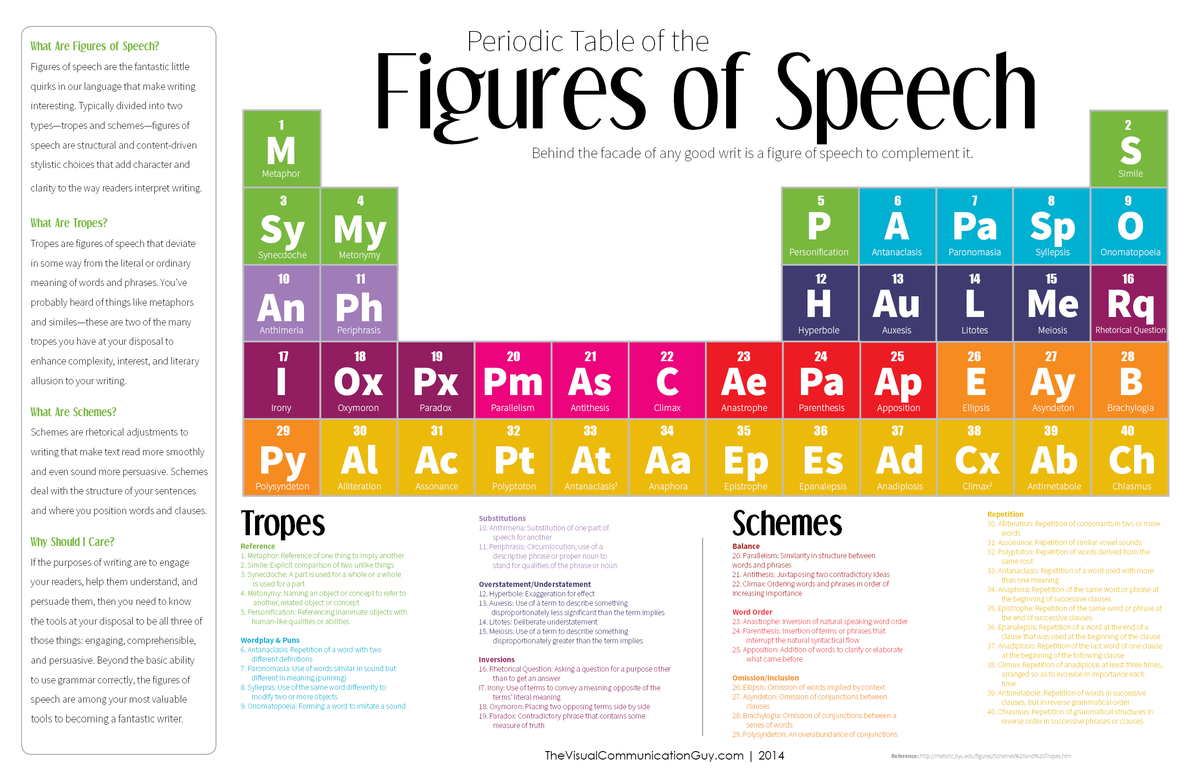
View the high resolution of this infographic by clicking here.
Figurative speech plays an important role in our ability to communicate with one another. It helps create compelling narratives, and evoke emotion in readers.
With this in mind, this periodic table graphic by Visual Communication Guy groups the 40 different figures of speech into two distinct categories—schemes and tropes.
What’s the difference between the two, and how can they help improve your writing?
Types of Schemes
In linguistics, a scheme is language that plays with sentence structure to make a sentence smoother, or even more persuasive, using syntax, word order, or sounds.
Here are four different ways that schemes fiddle with sentence structure.
Balance
This is especially important when trying to make a sentence smoother. A good example of balance is parallelism, which is when you use the same grammatical form in at least two parts of a sentence.
- Not parallelism: “She likes reading, writing, and to paint on the weekends.”
- Parallelism: “She likes reading, writing, and painting on the weekends.”
Word Order
Changing the position of words can have an impact on the way a sentence is understood. For instance, anastrophe is the deliberate reordering of words in a sentence to either emphasize a certain point, or distinguish a character as different.
- An example of anastrophe: “The greatest teacher, failure is.” -Yoda
Omission and/or Inclusion
Omissions and inclusions are useful in order to build suspense or add emotional expression to text. For example, an ellipsis is a form of punctuation that uses three dots (…) to either replace a word in a sentence or indicate a break in speech or an incomplete thought.
- Example of an ellipsis: “I was thinking of calling her Susie. Well, at least I was until…never mind. Forget I said anything.”
Repetition
Similar to the other types of schemes, repetition allows you to emphasize a certain point you want the reader to pay attention to, but it’s also used to create rhymes and poetry.
A well-known literary device, alliteration uses the same consonant sound at the start of each word in a sentence. It doesn’t necessarily have to be the same letter, so long as the sound is the same.
- A popular example is this nursery rhyme: “Peter Piper picked a peck of pickled peppers.”
- Another example: Phillip’s feet. (different letter, but same sound)
Types of Tropes
While schemes play around with the mechanics of a sentence, tropes stray from the literal or typical meanings to evoke emotion, and keep a reader engaged and interested.
Tropes help create an alternative sense of reality, using these five strategies.
Reference
These are literary devices that help paint a deeper picture of a concept, using a reference to something related, but different.
Metaphors and similes are common examples of references, but a lesser-known type of reference is a synecdoche, which is when a small part of something is used in reference to the thing as a whole.
- An example of a synecdoche: “Check out my new wheels.” (where wheels refer to a car)
Wordplay & Puns
This type of literary device plays with sounds or meaning to add depth to a sentence. For instance, a syllepsis uses one word to create parallels between two separate thoughts, while an onomatopoeia is a figure of speech that uses words (either real or made-up) or even letters to describe a sound.
- An example of a syllepsis: “When I address Fred I never have to raise either my voice or my hopes.” – E.B. White
- An example of an onomatopoeia: “Ding-dong” (the sound of a doorbell)
Substitutions
This is when someone replaces a word or thought with something else. For instance, anthimeria is the use of a word in a grammatical form it’s not generally used in, while periphrasis is when someone intentionally elaborates on a point, instead of expressing it succinctly.
- An anthimeria: “I could use a good sleep.” (Sleep is normally a verb, but here it’s used as a noun)
- Example of a periphrasis: Instead of saying, “It’s cold outside.” you say, “The temperature of the atmosphere when I exited my home this morning was quite chilly and exceptionally uncomfortable.”
Overstatement and/or Understatement
These are intentionally exaggerated, or downplayed situations that aren’t meant to be taken literally. A hyperbole is an example of an overstatement, while litotes are the opposite—deliberate understatements.
- An example of a hyperbole: I’m so hungry, I could eat a horse.
- While a litotes looks like this: It’s not rocket science.
Inversions
This type of literary technique uses contradictory ideas and indirect questions for dramatic effect, or to emphasize a point. For instance, an oxymoron is when two contradictory words are used back-to-back.
- An example of an oxymoron: Act natural
Using Figures of Speech to Craft Content
First, let’s just address it…Yes, I did use alliteration in the above header, and yes, now I’m using an ellipsis in this sentence.
Because let’s face it—in the age of information overload, writing articles that are interesting and compelling to readers is a top priority for online content creators. And using figurative language is a good way to keep readers attention.
So, if you’re a content creator yourself (or simply looking to beef up your knowledge on linguistics), hopefully this graphic has helped you on that journey.